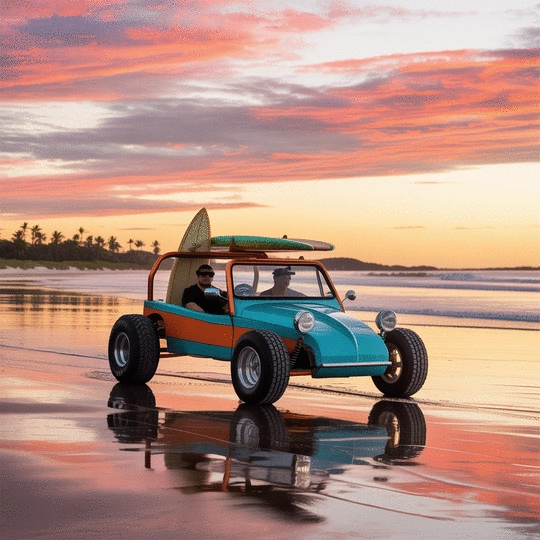Restoring a Classic Beach Buggy
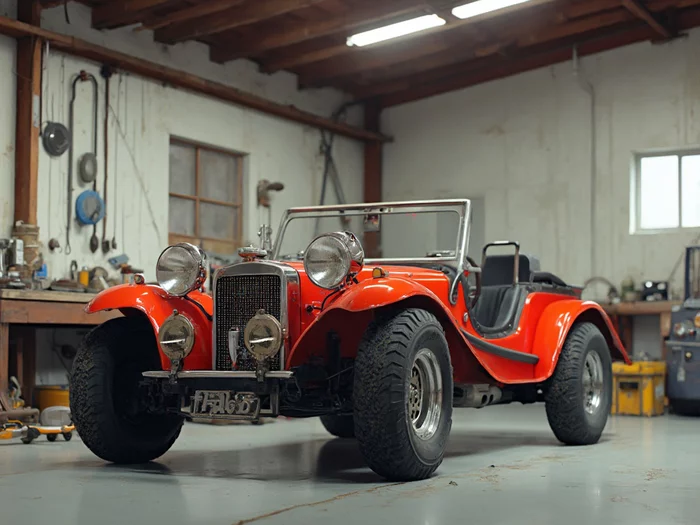
Posted on: 2025-10-13
By: Jasper Quinn
Have you ever considered how a simple car restoration project can turn into a journey filled with creativity, community, and personal growth? Restoring a beach buggy not only allows you to express your style but also connects you with a rich history of automotive culture.
What You Will Learn
- The significance of beach buggies as symbols of fun and adventure in automotive history.
- How to customize your beach buggy to reflect your personal style and preferences.
- The potential for increased resale value with a well-restored beach buggy.
- Essential preparations needed before starting your restoration journey.
- The importance of documenting your restoration process to inspire and help others.
- Various exciting avenues to explore after completing your restoration, including local events and modifications.
- How beach buggy restoration nurtures a thriving community of builders and enthusiasts.
The Beach Buggy Restoration Journey Milestones
Embarking on a beach buggy restoration involves distinct phases, from initial preparation to sharing your completed project. Here's a look at the typical stages and key activities in each.
1. Essential Preparations
- Research & Model Selection (e.g., Meyers Manx)
- Sourcing Parts & Tools
- Space & Budget Planning
2. The Restoration Process
- Disassembly & Inspection
- Chassis & Bodywork
- Engine & Electrical Rebuild
3. Customization & Completion
- Personal Expression & Upgrades
- Paint, Upholstery & Accessories
- Final Assembly & Testing
4. Sharing Your Journey
- Documenting Progress (Photos/Videos)
- Engaging on Social Media & Forums
- Attending Car Shows & Events
Understanding the Beach Buggy Restoration Journey
Restoring a classic beach buggy is not just a project; it's an adventure that brings enthusiasts like you closer to the heart of automotive culture. Whether you’re a seasoned mechanic or a passionate DIYer, embracing the beach buggy restoration journey can be incredibly rewarding. Imagine taking a vintage chassis and breathing new life into it, transforming it into a unique vehicle that reflects your personal style and passion for the beach!
So, what exactly is a classic beach buggy? It’s typically a lightweight, open-top vehicle designed for sandy terrains, often built on a Volkswagen chassis. Restoring one can offer a range of benefits, from enhancing its performance to showcasing its aesthetic appeal. Plus, you’ll gain the satisfaction of knowing you played a crucial role in preserving automotive history!
What is a Classic Beach Buggy and Why Restore One?
A classic beach buggy is more than just a car; it’s an icon of fun, freedom, and adventure. These vehicles were designed for excitement and versatility, making them perfect for sandy beaches and off-road trails. Restoring one allows you to honor its legacy while creating a custom ride that suits your style. You get to choose the engine, bodywork, and accessories that fit your vision.
Moreover, restoring a beach buggy can be a fantastic investment. In recent years, there has been a resurgence of interest in classic vehicles, and a well-restored buggy can significantly increase in value. So not only do you get to enjoy the ride, but you may also find yourself with a valuable asset in the end!
- Personal expression through customization
- Preserving automotive history
- Potential for increased resale value
Are you ready to start your restoration journey? The first step is understanding what you love about beach buggies and how you want to express that through your own build!
Common Types of Beach Buggies: Focus on the Meyers Manx
There are various types of beach buggies, but one of the most iconic is the Meyers Manx. This classic buggy was designed by Bruce Meyers in the 1960s and is celebrated for its lightweight fiberglass body and off-road capabilities. The Manx quickly became a symbol of the beach lifestyle, and its unique design has made it a sought-after model for restoration aficionados.
When considering which beach buggy to restore, you might also want to explore other popular models, such as:
- Volkswagen Beetle-based buggies
- Funky variants like the Sand Rail
- Vintage dune buggies from the 70s and 80s
Each model has its own charm and history, so take your time to research and find the one that resonates with you. I find that the journey of choosing the right buggy adds excitement to the restoration process!
The Historical Significance of Beach Buggies
The history of beach buggies is rich and colorful, reflecting the spirit of adventure and innovation. These vehicles emerged from the 1960s California surf culture, where enthusiasts sought a fun way to explore sandy beaches and coastal areas. As the popularity of beach buggies grew, so did the community of builders and restorers.
Today, beach buggies symbolize freedom and creativity, allowing owners to express their individuality. Restoring a beach buggy not only honors its past but also keeps the culture alive for future generations. By embarking on this journey, you’re contributing to a vibrant community that thrives on shared knowledge and passion. For those interested in broader automotive insights, the Society of Automotive Engineers (SAE) offers resources on vehicle design and restoration, providing a deeper understanding of the engineering principles behind these classic vehicles.
- A symbol of 1960s surf culture
- Community of builders and restorers
- Legacy of innovation and creativity
Have you ever thought about how your restoration story could inspire others? Each buggy carries a piece of history, and you have the chance to add your own chapter to that narrative.
Essential Preparations for Restoring Your Classic Beach Buggy
Before you dive into the actual restoration process, it's crucial to prepare adequately. This preparation phase lays the groundwork for a smooth journey ahead. Let's get started with the essentials!
For those looking into the regulatory aspects of vehicle modifications and restorations, the U.S. Department of Transportation (DOT) provides comprehensive resources on vehicle safety standards and regulations, ensuring your restored buggy is road-ready and compliant.
Engage with Your Community!
Have you ever participated in a beach buggy event or meet-up? These gatherings are not only a fantastic way to showcase your hard work but also a chance to connect with fellow enthusiasts. What type of events would you be most interested in attending? Let us know your thoughts below:
Frequently Asked Questions About Beach Buggy Restoration
Q: What is a classic beach buggy?
A: A classic beach buggy is typically a lightweight, open-top vehicle designed for sandy terrains, often built on a Volkswagen chassis, celebrated for its fun and adventurous nature.
Q: Why should I restore a beach buggy?
A: Restoring a beach buggy allows for personal expression through customization, preserves automotive history, and can potentially increase the vehicle's resale value.
Q: What are some common types of beach buggies?
A: The Meyers Manx is one of the most iconic types. Other common types include Volkswagen Beetle-based buggies, Sand Rails, and vintage dune buggies from the 70s and 80s.
Q: What are the essential preparation steps for restoration?
A: Essential preparations include research and model selection, sourcing parts and tools, and planning your space and budget. This groundwork ensures a smoother restoration process.
Q: How can I share my restoration journey and connect with others?
A: You can share your journey by documenting progress with photos/videos, writing detailed guides, engaging on social media, and participating in online forums. Attending car shows and events also helps connect with the community.
Reflecting on Your Beach Buggy Restoration Experience
Congratulations on completing your beach buggy restoration journey! The satisfaction of seeing your hard work and creativity come to life is truly unmatched. Now, it’s time to reflect on this experience and consider how you can inspire others who share your passion for beach buggies. Sharing your journey not only helps fellow restorers but also enhances your own enjoyment of the hobby!
Reflecting on your process can be both fun and rewarding. Think about the challenges you faced, the skills you developed, and the moments that made you smile. Why not document your journey through a blog or social media? It’s a fantastic way to connect with others and showcase your unique build!
Sharing Your Journey: Inspiring Other Restorers
Sharing your restoration process can motivate and guide other enthusiasts looking to tackle their own projects. Here are some ways to effectively share your journey:
- Document Progress: Take photos and videos at each stage to highlight your work.
- Write Detailed Guides: Explain the techniques and tools you used in your restoration.
- Engage on Social Media: Post updates and insights on platforms like Instagram or Facebook.
- Join Online Forums: Participate in discussions to share tips and learn from others.
By sharing your experience, you open the door for others to learn and feel inspired to embark on their own beach buggy restoration projects. Remember, every restoration has a story, and yours could be the spark that ignites someone else's passion!
Continuing Your Beach Buggy Adventure: Where to Go Next
So, you've restored your beach buggy—what's next? There are plenty of exciting avenues to explore that will keep your passion alive and thriving. Here are some ideas to consider:
- Take It for a Spin: Experience the thrill of driving your restored buggy along the coast!
- Explore New Modifications: Consider what upgrades you could make to enhance performance.
- Participate in Local Events: Join beach buggy meet-ups, races, or other community gatherings.
- Expand Your Knowledge: Attend workshops or classes to refine your restoration skills further.
Each adventure with your beach buggy can lead to new experiences and friendships. Don’t be afraid to embrace every opportunity that comes your way!
Exploring Classic Car Shows and Events for Enthusiasts
As part of your ongoing beach buggy adventure, classic car shows and events are fantastic venues to connect with like-minded enthusiasts. These gatherings celebrate our shared passion and provide a platform to showcase your hard work. For those interested in the impact of recreational vehicles on natural environments, the National Park Service (NPS) offers information on conservation practices, which can provide valuable context for responsible beach buggy use in sensitive areas. Here are some events to keep an eye on:
- Local Car Shows: Participate in shows in your area to meet other enthusiasts and showcase your buggy.
- Beach Buggy Gatherings: Look for specific events dedicated to beach buggies where you can network.
- National Rallies: Plan to attend larger rallies that attract restorers from all over Australia.
- Workshops and Seminars: These can enhance your skills and provide invaluable insights from experts.
Attending events not only highlights your hard work but also allows you to learn from others and gain inspiration for future projects. Plus, who doesn’t love a good beach day with buggies all around?
Recap of Key Points
Here is a quick recap of the important points discussed in the article:
- Restoring a classic beach buggy is an adventure that allows for personal expression and customization.
- The Meyers Manx is one of the most iconic beach buggy models, celebrated for its design and off-road capabilities.
- Restoration not only preserves automotive history but can also enhance the vehicle's value significantly.
- Sharing your restoration journey through documentation and social media can inspire and connect with other enthusiasts.
- Engagement in local events and car shows offers opportunities to showcase your work and further your knowledge.
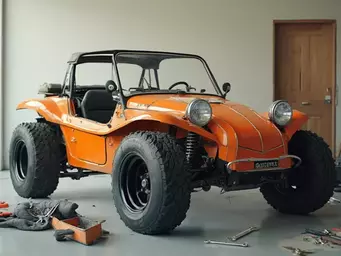 What if every turn of the wrench not only transformed your beach buggy but also deepened your passio
What if every turn of the wrench not only transformed your beach buggy but also deepened your passio
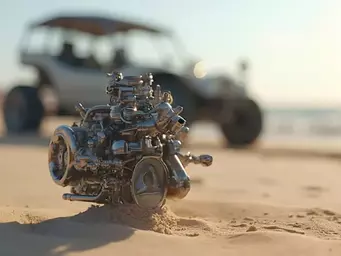 Upgrading your beach buggy isn't just about power—it's a journey towards better performance and en
Upgrading your beach buggy isn't just about power—it's a journey towards better performance and en
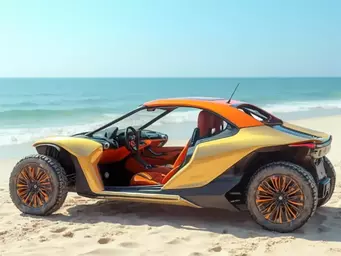 Have you ever felt the thrill of cruising along the shore in a custom beach buggy, the sun warming y
Have you ever felt the thrill of cruising along the shore in a custom beach buggy, the sun warming y
